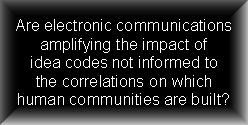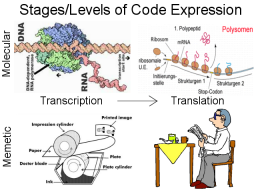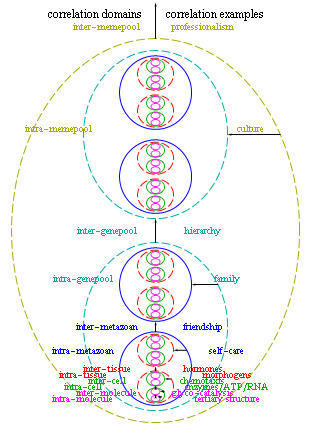


Gene "expression" translates molecule strings (replicable nucleic acid codes) into the proteins and enzymes needed to run a cell. Bacterial cells (prokaryotes, i.e. cells without a nucleus) have fewer ways to control which codes they express than do the eukaryotic cells of plants and animals. In bacteria, what's there as code may get expressed whether it's appropriate or not. That's why only eukaryotes are able to do cool things like assemble a bobcat or human from a single cell.

Idea "expression" in the same sense translates memetic codes, e.g. a blueprint, into behaviors or possibly even into a building. Newspapers, for example, transcribe stories for distribution while the translation itself is done by their readership, one sentence at a time. This similarity between genes and ideas is not just metaphorical. To wit, the 2nd law of thermodynamics applies to both types of expression by prescribing a minumum energy cost for each step in the process. Just as going digital with molecule codes made a big difference for one-celled lifeforms, going digital with idea codes could do the same for us metazoans (if it doesn't do us in first).
The talk below* addresses this question: How may we better inform idea-expression in metazoan communities to multiple layers of community structure? Consider this in light of the above-mentioned conclusion from molecular biology, that informed gene-expression in eukaryotes is crucial to the development and sustainable operation of individual metazoans. As with ideas, with genes an ability to adapt the codes expressed in light of inputs from more than one level of organization seems crucial e.g. to recovery from injury as well as to embryo development. Bacteria are in that sense our genetic ideologues, less able to inform their songs to issues on more than one scale. They are also more likely to be "all that's left" when we're confronted with decreasing thermodynamic availability i.e. less free-energy per capita and/or an unfriendly environment./pf
* Slides (IE works best) from a 15 May 2007 talk at UIUC (UCS 2007) on simplex models of layered niche-networks.

Notes for a followup talk (slides,pdf)/paper delivered on Oct 30, 2007 at the International Conference on Complex Systems in Quincy MA:

Given that informed gene-expression in eukaryotes is key to the development and sustainable operation of individual metazoans, how might we better inform idea-expression to multiple layers of community structure in metazoan communities? As in the case of nucleic acid codes on the molecular level, with ideas an ability to adapt the codes expressed (i.e. translated into structure or action) in light of inputs from more than one level of organization seems crucial to community well-being e.g. to recovery from disaster or resource depletion. Ideologues might in that sense serve as "prokaryotes in the idea pool", less able to inform their songs to issues on more than one scale but more likely to be "all that's left" when we're confronted with decreasing thermodynamic availability. Thus in the stuggle against devolution for our descendants, the past century's advances in electronic communication may be magnifying the impact of ideologies systematically uninformed to a subset of the correlations on which high-population human communities are built*.
Strategies to better inform action to correlations on multiple scales of space, time, and organization include:
